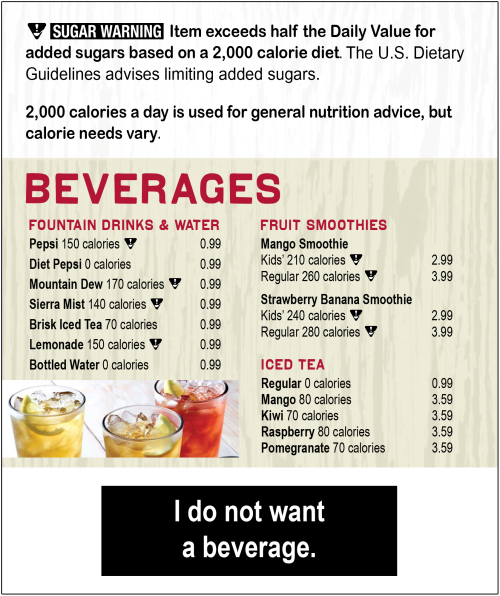But labels should be designed for higher visibility, researchers suggest
University of California - Davis

Example of a simulated label used in the study.
Added-sugar warning labels reduced the likelihood that consumers would order items containing high amounts of added sugar in an online experiment led by University of California, Davis, researchers.
Menu labels can help inform consumers about the surprisingly high amount of added sugar in even the smallest sizes of soda or in unexpected items like salad dressings and sauces.
In a randomized controlled trial, researchers found that warning labels reduced the probability of ordering a high-added-sugar item by 2.2%.
However, only 21% of the consumers exposed to the added-sugar warning labels noticed them. Among those who noticed the labels, there was a reduction of 4.9 grams of added sugar ordered, compared to the control group.
"Given the frequency of restaurant food consumption, these modest effects could lead to meaningful changes in sugar intake at the population level, and the labels should motivate restaurants to reduce the added-sugar content of their menus," said Jennifer Falbe, a researcher in the Department of Human Ecology and lead author. Notably, it is estimated that 21% of calories consumed in the United States come from restaurants.
However,
given that most participants did not notice the added-sugar labels, Falbe
added, "our findings also indicate that menu labels should be designed for
higher visibility."
First look at behavioral outcomes
The
study, published online this week in the American Journal of Preventive Medicine, looked
at people's behavior as they simulated ordering from menus for fast-food and
full-service chain restaurants. Co-authors include researchers from other
universities and the Center for Science in the Public Interest.
Falbe said this study is the first to test a restaurant menu
added-sugar warning label on behavioral outcomes. In the study, consumers
selected menu items they would want to order for dinner from online menus that
included common foods like hamburgers, salads, French fries, beverages (with
sugar and sugar-free), sodas, cookies, sundaes and smoothies.
More
than 15,000 participants were recruited to match the U.S. population in terms
of age, gender, race and ethnicity, and education. Half of them were randomized
to select from online menus with added-sugar warning labels while the other
half selected from menus without added-sugar labels (the control group). In the
intervention group, warning labels had been added to items containing over 50%
of the recommended daily limit for added sugar. Researchers were able to record
all participants' behavior as they simulated ordering dinner from those menus
in 2021.
Major
findings include:
- Added-sugar warning labels reduced the likelihood that consumers would order an item high in added sugar.
- The warning labels helped consumers understand whether menu items were high in added sugar.
- A large majority, or 72%, of consumers in the study indicated that they supported a law requiring chain restaurants to post these warning labels on their menus.
Falbe
and colleagues had conducted previous studies on developing such warning
labels, including one that designed added-sugar menu labels based on the design
of existing sodium warning labels present on menus in New York and
Philadelphia.
While
the United States Food and Drug Administration requires large chain restaurants
to make some nutrition information available in restaurants, there is currently
no requirement for added sugar to be publicly disclosed for restaurant foods,
researchers said.
"This
gap in information leaves consumers in the dark about how much added sugar is
contained in the foods and drinks that they consume," said DeAnna Nara, a
senior policy associate at Center for Science in the Public Interest and
co-author. "We know that chain restaurants serve up foods and beverages
packed with added sugars and are especially hard places for consumers to
navigate and make healthy choices for themselves and their families, especially
those managing chronic diseases."
"Warning
icons provide easily interpretable information to consumers and equip them with
the information they need to make informed decisions," said Nara.
"They also have the potential to encourage restaurants to rethink their
recipes, spurring reformulation to cut back on added sugars."
Co-authors
of the study include researchers from UC Davis, Harvard T.H. Chan School of
Public Health, Perelman School of Medicine at the University of Pennsylvania,
Center for Science in the Public Interest in Washington D.C., and the
University of North Carolina at Chapel Hill.
Funding was provided by Bloomberg Philanthropies to CSPI. Bloomberg Philanthropies and CSPI played no role in the data collection, experimental design or analysis of the data. Researchers were also supported by career development and training grants from the NIH.